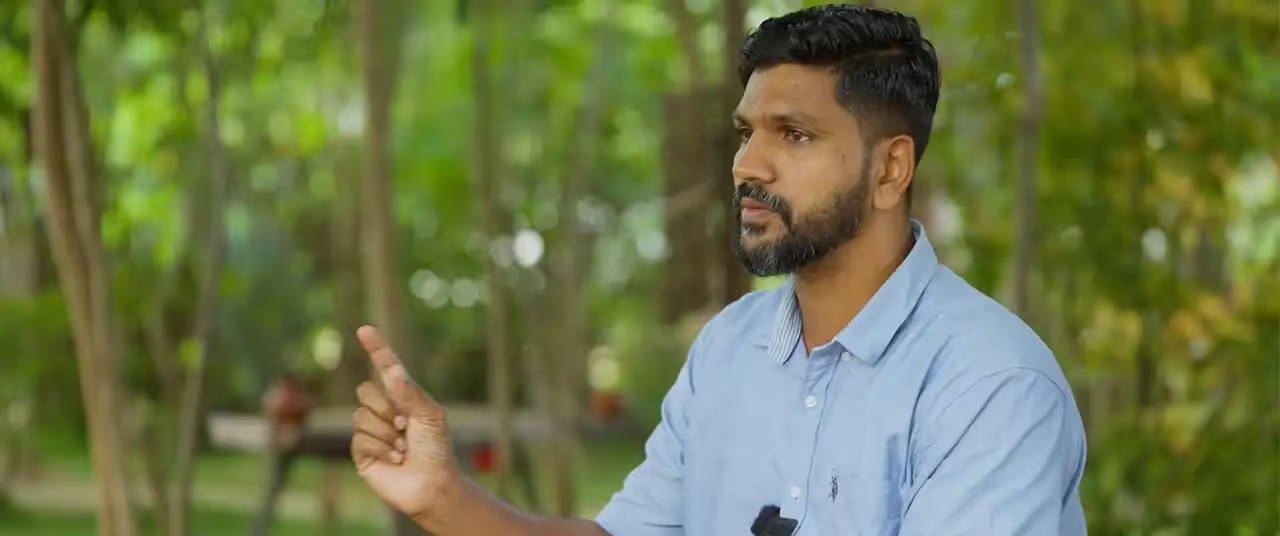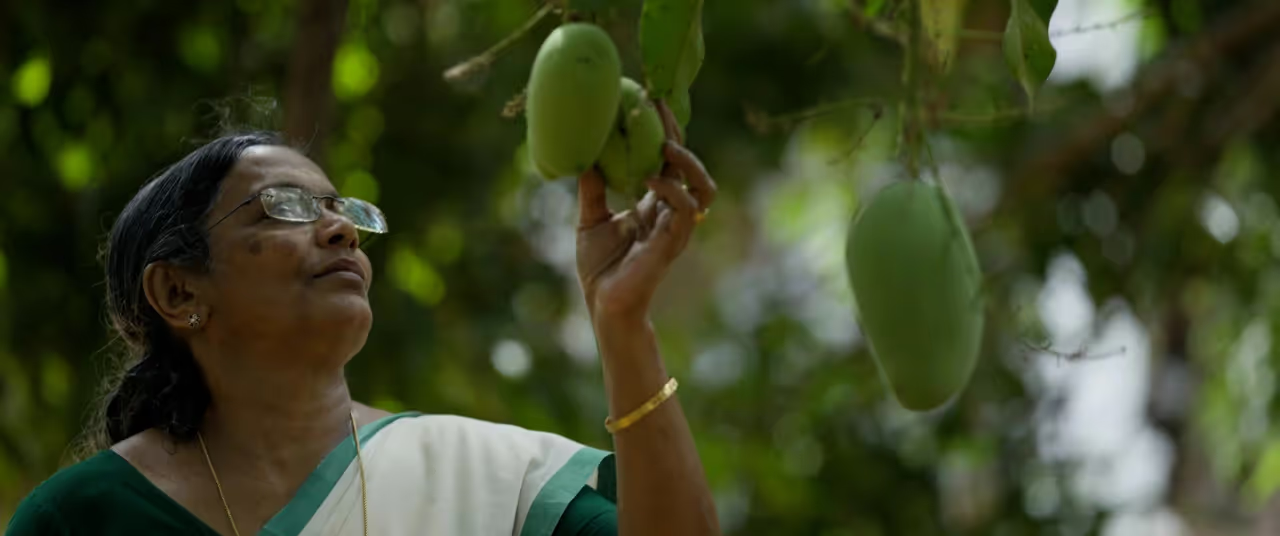Now 79, Abdul Kareem guards his thriving creation with care






Nearly five decades ago, in a remote village in northern Kerala, a young man made an audacious decision to transform five acres of barren, rocky land into a forest. The odds were stacked against him. The sun was merciless, the soil was unyielding, water was scarce, and the villagers mocked his ambition. But Abdul Kareem was undeterred.
In 1977, he planted his first saplings, only to watch them wither and burn under the relentless heat. Yet, he refused to give up. With steely determination, he replanted. This time he carried water on his motorbike to nourish the fragile saplings. Nature tested his resolve again, and almost every plant perished. However, one tree—a wild Maruthu, or Arjun tree—stood tall against the odds. This lone survivor became his beacon of hope.
Undaunted, Kareem expanded his mission. Over time, he acquired an additional 27 acres of barren land and continued planting. Slowly, the landscape began to change. By the year 2000, the once-sterile land had been transformed into a thriving forest, bursting with biodiversity. Remarkably, he never used fertilisers or engaged in weeding, allowing nature to take its own course.
The forest, now a sanctuary for numerous bird and animal species—including hornbills, green pigeons, wild hens, peacocks, wild boars, monkeys, snakes, and jackals—stands as a testament to one man's unwavering perseverance.
My forest needs my personal attention, far more than my own children do. Children grow on their own, but a forest demands constant care.
Also read: How an Alappuzha coir exporter nurtured a one acre forest
Now 79, Kareem remains the guardian of his creation, which has been fittingly named ‘Kareem’s Forest.’ Living in a humble home nestled within the greenery, he has forged an unbreakable bond with his surroundings. “My forest needs my personal attention, far more than my own children do. Children grow on their own, but a forest demands constant care,” he explains, justifying his choice to stay within its embrace.
Originally, the land had a single well that yielded around 500 liters of water on a peak summer day. However, as the forest thrived, the well was rejuvenated, storing over 10,000 liters of water daily during summer. Unsurprisingly, the forest became his home, providing his family with crystal-clear water, unpolluted air, and a naturally cool climate.

Learning conservation
Yet, Kareem candidly admits he was unaware of these benefits when he first embarked on his mission. “I created this forest for myself. Back in the ’70s and ’80s, I knew nothing about conservation.” At that time his only dream was to build a home in a serene, tranquil retreat, far from the hustle and bustle of city life. It was the heartfelt longing of someone who had once cherished nature but had to leave it behind to make a living.
After completing Grade 12 in 1964, he moved to Mumbai to earn a living. He worked as a labourer in a private dockyard for four years before returning to his hometown, Nileswaram. During the Gulf boom of the early 1970s, Kareem recognised a major business opportunity and established a travel and placement agency to recruit job seekers for the UAE, Bahrain, Kuwait, Oman, Qatar, and Saudi Arabia. He also traveled extensively to the Gulf countries during this time.
{{marquee}}
Despite his busy schedule, he nurtured a dream of creating his own Kaavu, or sacred grove. "Back in school, I would escape to the nearby Kaavu whenever I had free time. The dark woods fuelled my imagination, and I felt truly alive," he recalls.
And that wasn’t the only time that Kareem felt one with the forest, as a child. He remembers, many times, looking at the hilltop near his home engulfed in flames. The fire swallowed up whole trees and little creatures, and Kareem asked his mother: who set the forest on fire? His mother explained the practice of slash and burn to him. He would watch birds flying, wondering where they were going. He became fascinated with trees, mountains and birds alike.

Years later, he would find this serenity again, in his own forest. In fact, his time in the sweltering lands of UAE played a role in the cool refuge he built back home. He experienced the scorching heat right down to his bones–something that inspired him to create a forest. But it wasn’t just the heat: in the 1970s, Kareem saw Sheikh Zayed plant flowering trees and lawns in the sprawling deserts of Dubai–even the soil had to be brought in from Iraq. Then why couldn’t he do this in Kasargod?
His dedication has not only revitalised the land but has also had an astonishing impact on the village of Puliyamkulam, located 45 km east of the district headquarters of Kasaragod. Once plagued by acute water scarcity, the village now flourishes with abundant groundwater reserves. “The forest has raised the water table. Every well along its periphery brims with water throughout the year,” Kareem says.
No city or hotel in the world can match the serenity of my forest. These days, I find urban settings and air-conditioned spaces suffocating. I long to be amid nature.
His bond with nature is deeply personal. The melodious chirping of birds fills his mornings with joy. “I feel like they are talking to me,” he says. “They grow restless if I am away for more than two days. When I return, they gather around me. I make sure they have fresh water to drink. They repay me by bringing in new seeds, enriching the biodiversity of my forest.”
Also read: Tarachand Belji is turning farmers into eco-warriors
Transformation of life
Today, Kareem’s Forest is a lush sanctuary, home to over 800 varieties of plants and shrubs, forming a self-sustaining ecosystem. But the transformation extends beyond the land. It has reshaped him, too.
Once a frequent traveller who enjoyed the luxuries of city life while working in the UAE’s travel industry, Kareem now finds peace only in nature’s embrace. “No city or hotel in the world can match the serenity of my forest. These days, I find urban settings and air-conditioned spaces suffocating. I long to be amid nature,” he says.
His commitment has not gone unnoticed. Global leaders, scientists, and renowned personalities have praised his work. Among them are former US President Barack Obama, former Vice President Al Gore, UAE ruler Sheikh Mohammed bin Zayed, and Indian superstar Amitabh Bachchan. In 2000, India’s Green Revolution pioneer, Dr MS Swaminathan, visited Kareem’s Forest. “I dedicated a large tree to him,” Kareem recalls. “Even today, scientists and researchers come to explore and learn from my forest.”
Kareem’s remarkable journey has not only transformed a barren landscape but has also found its place in academic curricula. The Kerala education department has included his story in the Class 6 Malayalam textbook, while the Central Board of Secondary Education (CBSE) features it in the Class 4 syllabus, inspiring young minds across the country.

His efforts have grown beyond India and gained colourful global recognition. Trinity College in Hartford, Connecticut, has chosen Kareem’s Forest as a model for greening, and universities in India and abroad have made his work a subject of study. Even the Indian government, along with various agricultural and forestry departments, is now exploring ways to replicate his pioneering efforts in other arid regions.
Also read: How the 'makrei' sticky rice fosters love, labour in Manipur
Despite his growing fame, Kareem remains true to his principles. His forest welcomes visitors, but there is one strict rule: no plastic. This stems from a personal tragedy. “In 1997, my cow died after ingesting a discarded plastic bag that once held salt. It was a wake-up call. Even today, I actively collect plastic waste. What disheartens me most is that even educated people are polluting the environment with plastic,” he laments.
For Kareem, environmental conservation is not just about planting trees. “Not everyone can plant a tree, but everyone can contribute in their own way. We all should strive to save our dear planet,” he says.
(Image Credits: Sandeep S, Sreejith M)
Explore other topics
References























.avif)

.avif)




